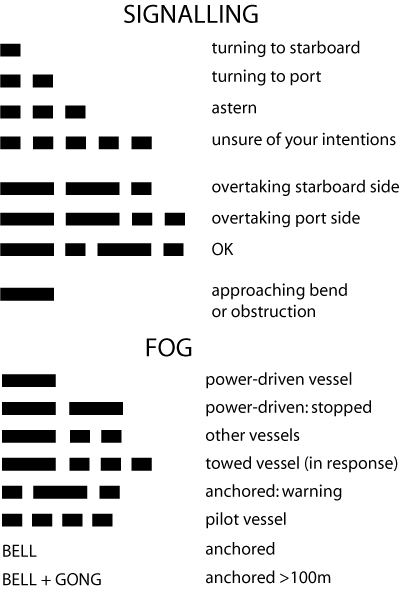4.3 Sound and Light Signals
This section is about signalling between vessels. This is done mainly with sounds, and sometimes lights are also used to back up the sound signals. You will find the full "chapter and verse" in Section D of the IRPCS, entitled Sound and Light Signals.
The Regulations include specifications of the equipment to be used, which we will not elaborate here.
As with the lights, the important thing as a skipper is to:
a) know what sounds you are expected to make and the right equipment to carry on board
b) recognise the signals that other vessels are making for your benefit.
Most yachts carry aerosol signalling horns if they do not have an electric horn installed, plus a bright torch or spotlight.
There are two categories where specific signals are defined: Manoeuvring and Warning Signals, and Restricted Visibility (Fog) Signals.
There are also Signals to Attract Attention (RULE 36), but these are simply any sound or light signal that cannot be mistaken for the other categories. If someone sets off a white flare, or shines a spotlight at you, they are trying to attract your attention. Similarly you can do these things (or shine a light on your sail) if you think another vessel hasn't seen you.
Manoeuvring and Warning Signals (RULE 34)
The first four signals are important to learn, because they are used by large vessels to tell us what they are doing - so doing the correct thing in response depends on immediately understanding what they are telling you.
"Short blast" means about a second, and these can be reinforced by light signals.
One short blast: I am altering my course to starboard
Two short blasts: I am altering my course to port
Three short blasts: I am operating astern propulsion (i.e. slowing down, stopping and/or going in reverse)
Five short blasts: I am unsure of your intention, or I am unsure you are taking sufficient action to avoid collision: diplomatic language for Get Out Of The Way.
There is another group of signals that you are less likely to hear, or have to react to. They concern one vessel intending to overtake another in a narrow channel.
Two long blasts and one short blast: I intend to overtake you on your starboard side
Two long blasts and two short blasts: I intend to overtake you on your port side
The vessel being overtaken can signal her agreement with: one long, one short, one long, one short.
(This is morse code "Charlie", meaning "OK" - easily remembered because it sounds like "Charlie Charlie")
The final sound in this section is one prolonged blast (four to six seconds) which is used by vessels in narrow channels coming up to a bend or obstruction. It is answered by the same signal from another vessel coming the other way.
Sound Signals in Restricted Visibility (RULE 35)
There is a list of these, reflecting the need to identify to other vessels what kind of vessel you are. Most of them are repeated every two minutes or so.
One prolonged blast: power-driven vessel making way
Two prolonged blasts: power-driven vessel stopped (but not anchored)
One prolonged and two short blasts: not under command, restricted in ability to manoeuvre (including when anchored), constrained by draught, sailing vessel, engaged in fishing (including when anchored), engaged in towing or pushing. In other words, everything that a power-driven vessel has to give way to.
One prolonged and three short blasts: the vessel being towed. Ideally this signal is made immediately after the towing vessel's signal.
Bell (rapid ringing for five seconds - at one minute intervals): vessel at anchor. Vessels aground also sound three distinct strikes of the bell immediately before and after the rapid ringing.
Bell plus Gong (for five seconds): a vessel over 100m in length at anchor sounds the bell in the forepart of the vessel, then immediately sounds the gong in the after part.
One short, one prolonged and one short blasts: vessel at anchor to warn an approaching vessel.
Four short blasts: pilot vessel engaged on pilotage duty.
Skippers need to know what sounds they are required to make. When underway, a motor boat (or yacht motoring) gives a prolonged blast every two minutes. When sailing, one long and two short.
Vessels less than 12m are not obliged to make these signals but should make some other sound every two minutes.
At anchor, vessels less than 20m are not obliged to give the bell signal but should make some other sound every two minutes. 
Learn the first four!
